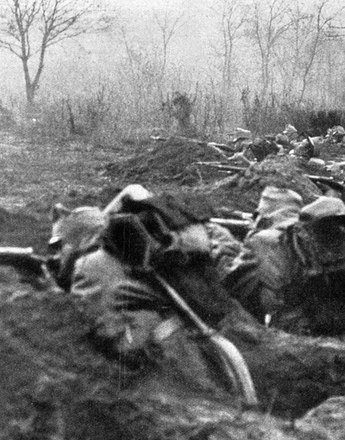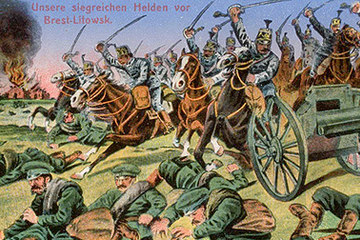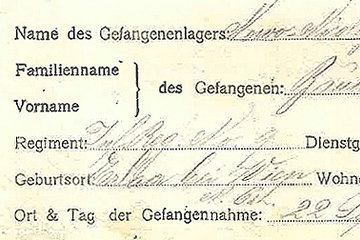In addition to the press, the Censorship Group within the War Monitoring Office also dealt with telegrams. This essentially involved two measures: “the closure of certain telegraph offices” (for instance in the broader area of the front) and “the monitoring and control of telegrams by what were known as Censorship Commissions”. The latter were set up in a number of cities of the monarchy (Vienna, Krakow, Lviv, Prague, Innsbruck, Graz, Trieste and Zadar) at the start of the war, and were under the control of the armed forces, with staff comprising military and telegraph officials.
The practical implementation of this telegram censorship involved the various telegraph offices working together with the Telegram Censorship Commissions. The former's function was to check the identity of the sender of the telegram and to pass on to the Commissions any suspicious telegrams and all telegrams sent abroad. The main function of the Telegram Censorship Commissions was to monitor telegrams sent to and coming from abroad. Telegrams to be "inhibited" (stopped) were passed on to the War Monitoring Office.
The censorship of photographs was above all intended to supplement press censorship. Photos to be published were first censored by “the Press Censorship Office or the Censorship Group of the War Monitoring Office”. Separate provisions applied to the photo-reporters of the War Press Headquarters. According to historian Gustav Spann, they were only to be assigned to the higher commands and from there allocated to a specific unit for a short period of time. Having completed their work at the front, the photo-reporters were required to return to the command centre to which they had previously been assigned. There they were permitted to develop the films, with each negative requiring detailed information: the place and time of the photograph, the details of the unit and whether the photograph was posed or not.
After the negative had been developed, “the command responsible carried out an immediate preliminary censorship”. Photos to be censored were kept back and passed on to the War Archive. According to Gustav Spann, 30 % of the pictorial material remaining was sent to the army administration. The photographer could use the remaining 70 % as he desired. However, these photos were checked a second time by the War Press Headquarters or the War Monitoring Office and only then released for publication.
Before the war, film censorship had been the responsibility of the Vienna Police Administration. Upon outbreak of the war, “an additional censorship office was set up for military films” – above all for those produced by the War Press Headquarters – which were censored by the War Archive. The censors were required to pay particular attention to ensuring that there were no ‘unpatriotic’ scenes in the films in question, and that no larger-scale “destruction and dramatic war scenes or the consequences of war” (for instance fallen soldiers) were shown. Nor should “enemy statesmen and military leaders” be shown in films.
Translation: David Wright
Mayer, Klaus: Die Organisation des Kriegspressequartiers beim k. u. k. AOK im Ersten Weltkrieg 1914-1918, Unveröffentlichte Dissertation, Universität Wien, Wien 1963
Spann, Gustav: Zensur in Österreich während des Ersten Weltkrieges 1914-1918, Unveröffentlichte Dissertation, Universität Wien 1972
Quotes:
„the closure of certain telegraph offices“: quoted from: Spann, Gustav: Zensur in Österreich während des Ersten Weltkrieges 1914-1918, Unveröffentlichte Dissertation, Universität Wien 1972, 155
„the monitoring and control of telegrams by ...“: quoted from: Spann, Gustav: Zensur in Österreich während des Ersten Weltkrieges 1914-1918, Unveröffentlichte Dissertation, Universität Wien 1972, 155
„The former's function was ...“: Spann, Gustav: Zensur in Österreich während des Ersten Weltkrieges 1914-1918, Unveröffentlichte Dissertation, Universität Wien 1972, 157
„the Press Censorship Office or...“: quoted from: Spann, Gustav: Zensur in Österreich während des Ersten Weltkrieges 1914-1918, Unveröffentlichte Dissertation, Universität Wien 1972, 163
„They were only to be assigned to the higher …“: Spann, Gustav: Zensur in Österreich während des Ersten Weltkrieges 1914-1918, Unveröffentlichte Dissertation, Universität Wien 1972, 163
„the place and time of the photograph …“: Spann, Gustav: Zensur in Österreich während des Ersten Weltkrieges 1914-1918, Unveröffentlichte Dissertation, Universität Wien 1972, 163
„the command responsible ...“: quoted from: Spann, Gustav: Zensur in Österreich während des Ersten Weltkrieges 1914-1918, Unveröffentlichte Dissertation, Universität Wien 1972, 163
„30 % of the pictorial material remaining …“: Spann, Gustav: Zensur in Österreich während des Ersten Weltkrieges 1914-1918, Unveröffentlichte Dissertation, Universität Wien 1972, 164
„The photographer could use the remaining 70 % …“: Spann, Gustav: Zensur in Österreich während des Ersten Weltkrieges 1914-1918, Unveröffentlichte Dissertation, Universität Wien 1972, 164
„censorship office was set up for military films“: quoted from: Spann, Gustav: Zensur in Österreich während des Ersten Weltkrieges 1914-1918, Unveröffentlichte Dissertation, Universität Wien 1972, 160
„destruction or dramatic war scenes ...“: quoted from: Spann, Gustav: Zensur in Österreich während des Ersten Weltkrieges 1914-1918, Unveröffentlichte Dissertation, Universität Wien 1972, 162
„‚enemy statesmen and military leaders“: quoted from: Spann, Gustav: Zensur in Österreich während des Ersten Weltkrieges 1914-1918, Unveröffentlichte Dissertation, Universität Wien 1972, 162
-
Chapters
- "Wartime absolutism" – and the revocation of civic rights
- The War Monitoring Office and press censorship
- Blank spaces, everywhere!
- Everything is censored!
- Monitoring of the post – letter censorship
- Censorship with ink and scissors and seeking for information material
- “Hypercensorship” and mood reports
- Circumventing the censorship and "self-censorship"







